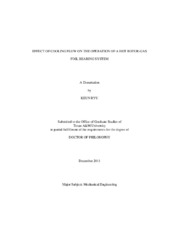| dc.contributor.advisor | San Andrés, Luis | |
| dc.creator | Ryu, Keun | |
| dc.date.accessioned | 2012-02-14T22:19:49Z | |
| dc.date.accessioned | 2012-02-16T16:18:14Z | |
| dc.date.available | 2012-02-14T22:19:49Z | |
| dc.date.available | 2012-02-16T16:18:14Z | |
| dc.date.created | 2011-12 | |
| dc.date.issued | 2012-02-14 | |
| dc.date.submitted | December 2011 | |
| dc.identifier.uri | https://hdl.handle.net/1969.1/ETD-TAMU-2011-12-10391 | |
| dc.description.abstract | Gas foil bearings (GFBs) operating at high temperature rely on thermal management procedures that supply needed cooling flow streams to keep the bearing and rotor from overheating. Poor thermal management not only makes systems inefficient and costly to operate but could also cause bearing seizure and premature system destruction. To date, most of thermal management strategies rely on empirically based "make-and-break" techniques which are often inefficient.
This dissertation presents comprehensive measurements of bearing temperatures and shaft dynamics conducted on a hollow rotor supported on two first generation GFBs. The hollow rotor (1.36 kg, 36.51 mm OD and 17.9 mm ID) is heated from inside to reach an outer surface temperature of 120 degrees C. Experiments are conducted with rotor speeds to 30 krpm and with forced streams of air cooling the bearings and rotor. Air pressurization in an enclosure at the rotor mid span forces cooling air through the test GFBs. The cooling effect of the forced external flows is most distinct when the rotor is hottest and operating at the highest speed. The temperature drop per unit cooling flow rate significantly decreases as the cooling flow rate increases. Further measurements at thermal steady state conditions and at constant rotor speeds show that the cooling flows do not affect the amplitude and frequency contents of the rotor motions. Other tests while the rotor decelerates from 30 krpm to rest show that the test system (rigid-mode) critical speeds and modal damping ratio remain nearly invariant for operation with increasing rotor temperatures and with increasing cooling flow rates. Computational model predictions reproduce with accuracy the test data. The work adds to the body of knowledge on GFB performance and operation and provides empirically derived guidance for successful integration of rotor-GFB systems. | en |
| dc.format.mimetype | application/pdf | |
| dc.language.iso | en_US | |
| dc.subject | Foil Bearings | en |
| dc.subject | Oil-Free Turbomachinery | en |
| dc.subject | Thermal Management | en |
| dc.title | Effect of Cooling Flow on the Operation of a Hot Rotor-Gas Foil Bearing System | en |
| dc.type | Thesis | en |
| thesis.degree.department | Mechanical Engineering | en |
| thesis.degree.discipline | Mechanical Engineering | en |
| thesis.degree.grantor | Texas A&M University | en |
| thesis.degree.name | Doctor of Philosophy | en |
| thesis.degree.level | Doctoral | en |
| dc.contributor.committeeMember | Palazzolo, Alan | |
| dc.contributor.committeeMember | Kim, Yong-Joe | |
| dc.contributor.committeeMember | Jo, Javier | |
| dc.type.genre | thesis | en |
| dc.type.material | text | en |


